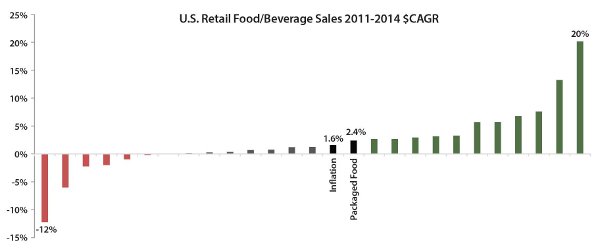U.S. Packaged Foods at a Crossroads
 Where can today’s leading food companies find pockets of growth? What will it take to pursue these new pockets of growth? What are the key strategic implications for the larger enterprise as a whole?
Where can today’s leading food companies find pockets of growth? What will it take to pursue these new pockets of growth? What are the key strategic implications for the larger enterprise as a whole?
In the past five years, roughly half of the largest packaged food and beverage holding companies have been unable to keep their U.S. retail topline growing commensurate with either inflation or the sector average.
It is the small incumbents and private label that are generating the most consistent, strong growth in the market.
Recent Performance of Top 25 Food/Beverage Holding Companies in U.S. Retail
Source: Euromonitor, 2015; Hartman analysis by company
In this quarter’s issue of Hartbeat Exec, U.S. Packaged Foods at a Crossroads, we share the results of months of analytical work pursuing the secret to unlocking real pockets of growth at the category level. What we developed is a new framework that explodes and replaces traditional snapshot market segmentation methodologies designed for everyday management with a trended framework built out of new variables that are anchored in a new cultural mindset around food spreading out from the urban cores of America.
Traditional market segmentations are biased towards mapping scale and dominance, more than what is likely to grow.
They do this by ignoring entire channels (e.g., natural/specialty, e-commerce) and entire categories of brands, particularly early-stage or premium brands that are deemed ‘too small individually to affect share dynamics.’ The rise of Chobani shows how dangerous that kind of dismissal can be. Traditional segmentations also usually offer static or, at best, YoY time perspectives that do not indicate where the money is moving.
Ultimately, segmentations built for line management cannot necessarily isolate and interpret the actual pockets of growth operating beyond legacy brands. They focus all strategic attention on the dominant cash cows in each category.
This quarter, Hartbeat Exec introduces a new framework to map your brands and isolate the key pockets of growth at work in your operating categories. The framework is built from three key variables that intersect to focus us quickly on the fastest growth pockets and white spaces waiting to be tapped.
The key variables are:
- Relative Quality (Premium/Non-Premium): This simple, binary distinction is the most powerful disruptor in contemporary food culture. It aligns to the distinction between ‘natural food’ and ‘processed food’ or, among the truly hard core, the distinction between ‘real food’ and ‘junk food.’ Even those consumers who do not buy into premium or its growth drivers can recognize the boundary when we speak with them or show them products on that side of this symbolic divide. They just find premium to be either pretentious or currently overpriced (e.g., organic).
 Relative Cultural Familiarity (Traditional vs. Emerging Food): Emerging foods are those that are literally new to American food culture in the last 20–25 years (e.g., hummus, nutrition bars, energy drinks, bottled water). This means that the majority of Americans, even young adults, consider them new. Traditional American foods (e.g., beef burgers, saltine crackers, sandwich cookies, condensed mushroom soup) are those that sell to a broad swath of U.S. households and have done so for three decades or longer. The majority of Americans instantly frame these foods as ‘American,’ even if some, like pasta, clearly do not pre-date the 20th century. Even newly arrived immigrants have a distinctly clear frame of traditional American foods due to the broad fascination with them in emerging markets.
Relative Cultural Familiarity (Traditional vs. Emerging Food): Emerging foods are those that are literally new to American food culture in the last 20–25 years (e.g., hummus, nutrition bars, energy drinks, bottled water). This means that the majority of Americans, even young adults, consider them new. Traditional American foods (e.g., beef burgers, saltine crackers, sandwich cookies, condensed mushroom soup) are those that sell to a broad swath of U.S. households and have done so for three decades or longer. The majority of Americans instantly frame these foods as ‘American,’ even if some, like pasta, clearly do not pre-date the 20th century. Even newly arrived immigrants have a distinctly clear frame of traditional American foods due to the broad fascination with them in emerging markets.
- Relative Cost (Hi Price/Mid Price/Low Price): If there’s one marketing “P” both consumers and CPG line managers see in very similar ways, it’s price. Consumers are very good at sniffing out the average-, low- and high-priced products at the shelf, because pricing information is highly transparent in stores (and increasingly across channels in real time). Our approach maps a brand’s weighted average unit pricing to represent the ‘average’ shelf price a brand’s consumer is noticing and paying. This is the most critical price with which to understand your competitive positioning in the market.
If you’d like to see how these variables combine to unlock real pockets of growth, please download this quarter’s issue of Hartbeat Exec for the full report and more detail on how this new framework can help your organization isolate new pockets of growth as well as set new growth strategies for your existing brands.

